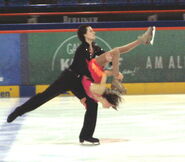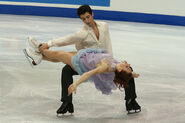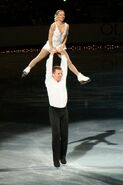right and right.]] Figure skating lifts are a required element in right and right. Pairs lifts differ from dance lifts most notably in that dancers are not allowed to lift their partners above their shoulders. Lifts are also executed by right teams in the free program in competition, as part of a movements in isolation requirement.
Dance lifts[]
right & right perform a reverse lift.]] Dance lifts are differentiated by the skating involved. There are seven kinds of lifts approved for right competitions.
Short lifts[]
These lifts may last up to six seconds in competition on the senior level.
- Stationary Lift - A lift performed "on the spot". The lifting partner does not move across the ice, but is allowed to rotate.
- Straight Line Lift - The lifting partner moves in a straight line across the ice. This lift may be performed on one foot or two.
- Curve Lift - The lifting partner moves along a curve across the ice. This lift may be performed on one foot or two.
- Rotational Lift - The lifting partner rotates in one direction while traveling across the ice.
Long lifts[]
These lifts may last up to ten seconds in competition on the senior level.
- Reverse Rotational Lift - The lifting partner rotates in one direction, then switches and rotates in the other direction, while traveling across the ice.
- Serpentine Lift - The lifting partner moves in a serpentine pattern across the ice.
- Combination Lift - A lift combining two of the four short lifts. Each part of the lift must be fully established.
Positions[]
Each position must be held for at least three seconds to count for levels. Each position is permitted only once a program.
For the lifting partner[]
- One foot
- right
- right - inside edge
- right - outside edge
- right - straight line, for the Straight Line lift only
- right
- Crouching, with both knees bent, on both feet
- Crouching, with one knee bent and the other leg extended to the side
- Lunge, with the free leg in any position
- One hand lift.
Only two of the above spread eagle positions may be used in a single program.
For the lifted partner[]
- Full split (180 degrees)
- Full right with the leg held above the head.
- Full doughnut/ring with one or both legs held close to the head
- Upside down combined with difficult hold
- Vertical position with a right
- A horizontal position with only one point of support
- Leaning forwards or backwards with the legs as the only points of support
- Full right with no support from the other partner above the thigh.
- Leaning out with the body and legs in a horizontal line with the shoulders and/or upper back as the points of support.
"Reverse" lifts[]
In ice dancing, the lifting partner is usually the man and the lifted partner is usually the woman. However, the rules allow for the woman to lift the man in competition. Notable couples who have performed "reverse" or "genderbending" lifts are right & right and right & right.
Extended lifts & program requirements[]
The right sets down length requirements for lifts in programs and skaters are penalized if a lift goes on for too long.
For the 2006-2007 season, at the senior level, the right required two lifts not to be longer than six seconds each. For the right, four lifts were required and they were separated into short and long.
Photo gallery of dance lifts[]
Pair lifts[]
right and right perform a hand-to-hand lift.]] right and right perform a twist lift]]
Unlike dance lifts, pair lifts are grouped by the holds involved. The ISU defines five different groups of pair lifts, with an ascending difficulty level, although levels 3 and 4 are the same level of difficulty. In ISU senior level competition, the man must rotate more than one times, but fewer than three a half. Lifts that go on longer may receive deductions. The group is determined by the hold held at the moment the woman passes the man's shoulder in the lift.
Lifts are named by either their takeoff and landing edges (in which case, they are named after the jump with the same sort of takeoff), the air position, or the method in which the lady is raised into the air.
Types of lifts[]
Group 1: Armpit hold lifts[]
- Lutz lift
- Flip lift
- right: The man and woman skate face to face, with the man going backwards. The lady lifts up from a forward outside edge (hence the axel name), and is set down again on the back outside edge. Platter lifts are either forward or reverse. In reverse platter lifts, the woman is skating backwards. In forward, she is skating forwards.
Group 3: Hand to hip lifts[]
- Cartwheel lift
- Star lift: The skaters skate face to face. The man has one hand on his partner's hip and the other clasping her hand. He raises her until she is horizontal with her free hand on his shoulder. The air position for this lift is a leg variation with her legs spread in a scissor position as if they were the points on a star, where is where the lift gets its name.
- Loop press/back press lift
Group 5: Hand to hand (lasso lift types)[]
- Step up lasso
- Toe lasso: The woman skates forward and the man skates backward. She is lifted into the air from a backward toe takeoff[1], like a right.
- Toe overhead lift: The woman is swung behind the man's head from one side of his body to the other, into a raised position. She is in a split position and they are facing the same direction.[2][3] The toe-pick is used in her take off, hence the name.[2]
- Step overhead lift: The same as the toe overhead lift, but the woman does not use a toe-assist in the take off.[2]
In hand to hand lasso lifts, the lady's position changes in the air. The lift begins with the skaters skating facing each other, but at the top of the lift, they are facing the same direction. The term lasso comes from the way the woman's body swings around as she changes position.[4] The woman takes off from a forward outside edge behind the man, and the take-off looks like an right.[2]
Lasso lifts are either forward or reverse. In reverse, the woman begins the lift skating backward. In forward, she is skating forward.[4]
A notable lasso variation is the helicopter. In this variation, the skaters perform a forward lasso lift, but the woman changes position at the top of the lift, parallel to the ice, with her back arched and her legs spread in a V position, so that as the man turns, her legs look like the blades on a helicopter.[4]
Positions[]
For the lifting partner[]
Unlike ice dancing, the lifting partner has only two possible positions.
- Rotating: Most lifts are performed with the man rotating across the ice.
- Carry: A carry lift is a lift in which the man does not rotate. He may skate on one foot, or perform right or a right to earn a higher level of difficulty.
For the lifted partner[]
There are three basic air positions for the lifted partner.[5]
- Upright: the lady's upper body vertical
- Star: the lady's position sideways with the upper body parallel to the ice.
- Platter: the lady's position flat, parallel to the ice, facing either up or down.
Illegal positions[]
right and right perform a one-handed "detroiter"]] right Any hold not listed above is not legal in ISU competition. However, there are many lifts which are common in show skating.
- The Detroiter is performed by the man lifting the lady over his head, holding her parallel to the ice while he is in a two-foot spin. The hold is the most dangerous part of the spin because the man is supporting the lady only by her legs. This move is also performed in more dramatic and dangerous fashion with a one-handed hold.
- A headbanger or bounce spin is performed by the man swinging the lady around with both of her feet off the ice, supported only by the man's grip on her ankle. The lady is elevated and lowered during the spin in a periodic fashion, sometimes with her head coming dangerously close to skimming the ice.
Twist lifts[]
Extended lifts & program requirements[]
Lifts may not last longer than three and a half rotations by the lifting partner in ISU senior level competition. Lifts that last longer will be penalized.
Lifts without rotations are called carry lifts and are allowed once in the long program.
For the 2006-2007 season, senior level competition required a maximum of three lifts, with one from group 3 or 4, and one twist lift in the long program. The short program required a hand-to-hand lift take-off from group 4, and a twist lift.
2007-2008 competition at the senior level will require a lasso-lift take-off (Group five).
Photo gallery of pair lifts[]
References[]
- ↑ Cite error: Invalid
<ref>tag; no text was provided for refs namedisu2006 - ↑ 2.0 2.1 2.2 2.3 Cite error: Invalid
<ref>tag; no text was provided for refs namedskate canada - ↑ Cite error: Invalid
<ref>tag; no text was provided for refs namedusfsa - ↑ 4.0 4.1 4.2 Cite error: Invalid
<ref>tag; no text was provided for refs namedskating for dummies - ↑ Cite error: Invalid
<ref>tag; no text was provided for refs namedisu1445
- U.S. Figure Skating - Glossary of Terms
- U.S. Figure Skating - Filling Out the Planned Element Sheets























